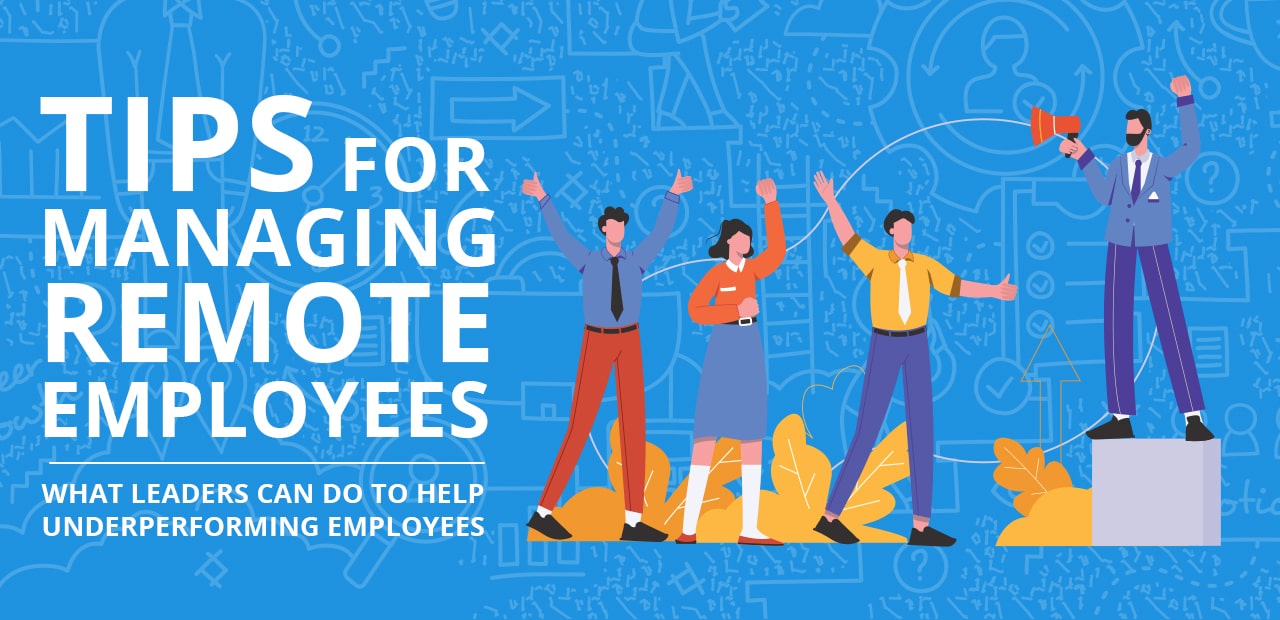Helping Underperformers Before It’s Too Late

When team members perform well, managing remote teams can be painless and hassle-free. But what if a remote employee or virtual assistant (VA) is underperforming? This is when remote team managers may find themselves in a challenging situation.
But before diving into the hows of managing underperforming remote workers, it’s important to find out if there are external factors that may have led to lackluster performance at work. Possible causes include the remote setup, the team’s dynamics, the leadership approach, and the remote workers’ personal lives.
Are you looking to build your own remote team? Discover these 9 Easy Steps for Building a Virtual Assistant Team, or schedule a free consultation with our Growth Experts today!
Possible reasons for underperforming remote employees
That managing remote teams is inherently easier than managing an on-site team is a common misconception. Managing people remotely can often be tricky, especially when there are few or no clear communication and collaboration protocols in place. It becomes particularly difficult when one has to manage a remote team with underperforming members.
Before you try to help an underperforming team member turn things around, it’s important to find out why the team member’s performance is slipping. And while it may be difficult, anyone managing remote teams must also look into their own leadership approach and their company’s internal ways of working to see if there are opportunities for improvement.
There are many factors that can affect a remote worker’s performance. Here are the most common ones:
Poor screening process
If an organization has poor screening and recruitment processes, it may be hiring remote team members that aren’t a good fit for the job description. Not taking the time to screen applicants properly can make managing remote teams more difficult than it should be.
Candidate-job mismatches can lead to poor performance and low productivity, potentially leading to remote workers feeling discouraged and uninterested in their work. Poor candidate screening processes can also make it more challenging to train employees since they don’t have the basic foundation or the relevant skills for the role. All these mean you’re setting yourself, the new hire, and the rest of your team for failure.
Need help finding the right VA for your business needs? Then it’s time to book your free consultation with 20four7VA.
A non-conducive remote work environment
A remote work environment can be challenging for some people, especially when they don’t have the right tools or access to do their job well. Remote workers should be able to access files and software from wherever they are in the world. This is the most basic support remote team managers can extend to their direct reports: equipping them with the right tools.
Within a remote setting, there’s also a good chance that employees may feel isolated and disconnected from their managers and the rest of their team. Situations like this can happen when people managing remote teams don’t value open communication and relationship building. This is a common occurrence, as many managers weren’t trained to manage hybrid teams or fully remote ones.
Lack of understanding of the work standards, scope of work, and ground rules
There are many advantages of working remotely with a distributed workforce. However, miscommunication or lack of communication can lead to a lack of common understanding of team members’ scope of work and the team’s ways of working. When there is no clear agreement on crucial details like a team member’s scope of work and their KPIs, it can lead to a task being done poorly or, worse, not being done at all.

Absence of performance management processes
It’s difficult to categorically state that someone is performing poorly without any documented performance indicators and review processes in place. Just as in-office employees have KPIs and performance appraisals, so should remote workers. The lack of a performance management process can add to the challenges of a remote manager dealing with a struggling remote employee.
Lack of direction and employee engagement
When managing remote teams, it’s important to find the balance between micromanaging and being an absentee manager.
A remote manager may become complacent when things are going well or if they have high-performing team members. But that doesn’t mean they should throw regular 1:1s, team syncs, and open communication out the window.
Even if the employees are the best at what they do, they will still benefit from great leadership and direction. Without these two things, team members can become demotivated and disengaged. A successful manager is someone who can help their team become better and work towards a common purpose.
Issues in an employee’s personal life
Work is just one small part of a person’s life. Effectively managing remote teams means understanding that there’s more to an employee than their productivity at work. Even if workers spend more than half of their waking hours at work, there are other parts of their lives that require their attention and energy. While some people are able to juggle their various responsibilities well, non-work situations may arise that overwhelm or shake even the most diligent and capable employees.
-
Family problems
Some employees prefer fully remote work or joining hybrid teams since these arrangements offer more flexibility. Workers can use the time they save from their daily commute to the office to focus on their home life.
However, fully remote work can have downsides, especially when boundaries aren’t properly set at home. The physical distance an office space offers can help many employees compartmentalize what’s happening at home and in their work life. In contrast, those who spend their working hours at home can be more affected or distracted by family problems since they’re more exposed to them.
-
Health problems
Whether they’re in an office or a remote work setup, employees can experience various physical and mental health issues. These problems can stem from a wide variety of factors and may not always be easily spotted, so it’s best to practice empathy when dealing with an underperforming employee.

The Great Exhaustion
Defined by researchers at the University of New South Wales, The Great Exhaustion is an absolute, overwhelming feeling of emotional exhaustion experienced by a large number of people in the workforce. Interestingly, studies show that women are disproportionately experiencing this feeling that has been described as having “nothing left in the tank.”
Aside from their professional responsibilities, women also take on more than half of the world’s unpaid work, which includes gender-segregated domestic work, child care duties, grocery shopping, etc. All these tasks combined can cause burnout and eventually lead to workers resigning from their jobs. This should be of great concern to employers because high turnover rates can cause businesses to spend more on recruitment and training.
Want to become a virtual staffing pro? Learn How to Set Up Your Virtual Assistant for Success today!
Tips for managing remote employees: what leaders can do to help underperforming team members
Managing remote teams means accepting the possibility of dealing with underperforming team members. Good managers can easily lead a team of high-performing employees, but great remote team managers can lead remote teams while helping underperforming employees improve.
1. Recognize red flags early
The saying “Prevention is better than cure” also applies to managing an underperforming remote worker. While observing body language and other physical signs may not be as simple through video conferencing, managers who take the time to pay attention will surely notice early signs of a struggling team member. Finding these early signs require remote team managers to have emotional intelligence and genuine concern. Once they find these early signs of a struggling or disconnected employee, they can keep close tabs by scheduling one-on-one virtual meetings to check in with the employee. During these meetings, they can identify leadership and employee performance gaps and co-design improvement plans.
2. Be specific with feedback
Every individual can react differently when presented with feedback on their performance. The best thing a remote manager can do is to give specific and objective feedback without mixing in emotional words. It’s also important to use wording that shows concern and support rather than criticism. A generic “You’re doing a poor job at your work” can be discouraging and too broad for employees to pinpoint where they should improve. A remote manager can be more specific and extend assistance with “Current performance reports show that you may be struggling with [task or project]. I want to help you be successful at it.”

3. Schedule a one-on-one virtual coaching session
Aside from regular team meetings, a remote manager should schedule one-on-one coaching sessions with an underperforming employee. This will allow the remote manager to check the employee’s performance and overall well-being. The regular sessions should be consistently done until both employee and remote manager feel that they’ve achieved the goals included in the co-designed performance improvement plan.
4. Discuss possible factors
The first one-on-one session should be about providing specific feedback on the employee’s performance and getting to know their point of view or the challenges they’re experiencing. The manager needs to establish that the sessions are a safe space for employees to voice their concerns. The first session can also be eye-opening for the manager, as they might get insights that can help them improve their leadership approach and remote work methods.
Employees might not be comfortable sharing their personal challenges during team meetings. A one-on-one session can help a manager understand the individual employee more. Both can openly discuss specific remote working challenges or issues the employee is experiencing. This way, both parties have a clearer picture of the situation before they move forward with the next steps.
5. Create a performance improvement plan
The manager and the employee should create a performance improvement plan together. Agreeing on the timelines, points of improvement, and metrics is important and provides a blueprint for the employee. The manager must also emphasize that committing to this plan does not only mean performing their current job well but can also help them with their career progression. This is a great venue for the manager and the individual employee to discuss ideas and get on the same page.
After working on the improvement plan via one-on-one calls, the manager must put this plan into writing. The employee must then agree to this documented improvement plan which will be the roadmap they will regularly refer to during the checkpoint video meetings.
Need more remote management tips? Book a free consultation and learn from our Growth Experts today!
6. Schedule regular checkpoint sessions
Managers may have a lot of things on their plate, but they must carve out time to schedule regular one-on-one video conferencing sessions with the underperforming team member. Showing up for a struggling employee can help inspire them to do the same for themselves and other remote team members. Remember, just because you’ve crafted the performance management or improvement plan doesn’t mean the plan will stick. It requires a joint effort between management and the employee.

7. Acknowledge improvements
Team managers may be impatient and expect an instant 180-degree change in performance. However, those with more experience with remote management know that changes like this take time and commitment. The regular checkpoint sessions will help managers see whether there are improvements and by how much. And if they do see improvements, remote managers are encouraged to practice giving positive feedback and recognition promptly. Doing so provides positive reinforcement and encourages the employee to continue committing to their improvement plan.
8. Create and implement a plan for lack of improvement
The happy path may consist of recognizing an underperforming employee, coaching the employee, and improving employee performance. But those with considerable experience managing virtual teams know that the happy path is not always the most common one. And a successful remote manager must know how to handle cases wherein they cannot see any improvement over the agreed period.
-
Job rotation or reassignment
Perhaps the employee is not improving simply because they do not have the right foundational skills or interest in the role. Therefore, they don’t feel compelled to excel in it. If the employee shows promise in other tasks, then a manager might want to assign him to other remote teams or departments. The receiving team may opt to take on the employee on a probationary period to see if they are a good fit. If not, then it may be time to pursue other options.
-
Written warnings
The continuous performance of individuals can affect their remote teams as well. And when that happens, it can negatively impact the other team members and the business itself. This is why managers must take the management of underperforming employees seriously. The continuous disregard or inability to follow through with the improvement plan is a sign of an offense against productivity and the work contract. Warnings must be given to the employee:
- Verbal warning
- Written warning
- Final written warning
Constant underperformance over a set period, even with verbal and written warnings, can warrant more serious consequences.
-
Potential dismissal
This is the final corrective action managers can take when dealing with an underperforming employee who has been showing no signs of improvement. As much as managers want to keep their remote teams intact, letting employees go may be the best option for businesses and individuals. Perhaps they will thrive in another role or carve a career path they are better suited for.
Dismissal of remote work employees may be difficult for managers, but they must also consider the rest of the team and the business. They might worry about spending more time finding or training a new hire. However, that might be a better way to spend their time than dealing with the effects of one’s poor performance.
9. Record recurring performance issues
The concept of remote work is still relatively new for most businesses. There is now one go-to handbook on how to manage remote teams, but remote work managers can use their experience in helping underperforming employees to create a performance plan of their own. Managers should document recurring performance issues and identify patterns. They can use insights from their data to establish required onboarding and training sessions before deploying a virtual assistant or remote talent. Managers can also use this information to craft what they think should be improved upon in their virtual workplace and management style.
Additional reminders for managing remote teams
-
It starts with recruitment and vetting
One of the main benefits of hiring remote workers is that managers have access to a wide pool of remote talent. They’re not confined to settling with someone just because of their capability to do on-site work. Remote team managers or business owners should take advantage of this benefit by working with a reputable remote staffing company like 20four7VA.
Let 20four7VA make life easier for you by helping you find the right remote talent for your business needs. Schedule a free consultation today!
2. Align on performance metrics and scope of work upon onboarding
Managing remote employees or remote teams can be easier when you’ve got a good foundation in place. It’s essential to over-communicate work standards, establish rules, and set clear expectations early on. Doing so gives remote employees a clearer idea of how they fit into the team and the business objectives.

3. Effective management requires consistency
To effectively manage remote employees, it must be consistent. Establishing regular communication and building relationships when working with remote teams may be challenging, but it’s not impossible. Managers must encourage people in their teams to reach out by creating a culture of open communication. Managers don’t just have the task of leading remote teams to accomplish projects; they also need to encourage team members and make them feel valued.
Aside from managing employees who are struggling, managers must also remember they are in charge of the rest of the remote working team. This means recognizing top performers and mentoring those who show promise so they can improve more.
4. Maximize the availability of online resources
There are many online resources and tools that help make life easier for managers. Synchronous and asynchronous communication apps help managers stay connected with their teams. Project management tools, on the other hand, provide remote managers and teams with much-needed visibility on the progress of projects and identify who needs more assistance.
Managers must also take advantage of free online training and courses for themselves and their remote teams. They can even find specific ones that can be included in an employee’s performance improvement plan. By maximizing the availability of such resources, managers are helping their employees upskill without spending more.
Working remotely offers great benefits to employees and employers alike. However, business managers must also be prepared for the challenges of managing remote workers, especially those who need more attention and coaching. Hopefully, these nine tips can help you in your remote management journey.
Do you need more information on virtual staffing? Visit the 20four7VA website for more info, or book your free consultation.










